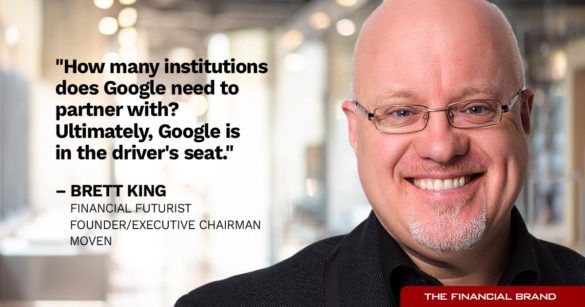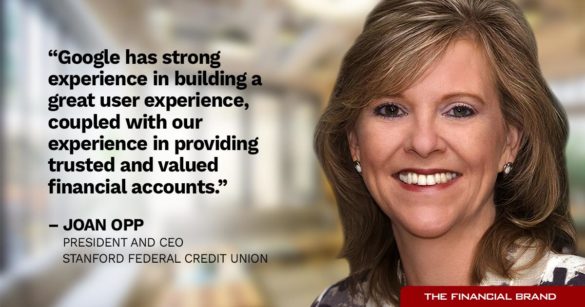Even after many warnings about the Big Tech threat — and several concrete developments, notably the launch of Apple Card with Goldman Sachs — the banking industry was still jolted by Google’s plan to offer “smart checking accounts” in partnership with financial institutions. The surprise development could bring significant changes to the fabric of how the industry serves consumers.
At the outset, there were more analysts and pundits talking about the Google plan than there were facts about the deal.
“The amount of attention this is getting is out of proportion to the details,” says industry blogger Ron Shevlin, Director of Research at Cornerstone Advisors.
News of the tech giant’s partnership with Citibank and with Stanford Federal Credit Union came out in mid-November 2019 in a bare bones story in The Wall Street Journal. No official announcement came out of Google or Citibank, though the credit union published a short written statement in the wake of the article. The two institutions are partnering with the search and tech giant to offer co-branded “smart” checking accounts through the Google Pay program starting in 2020.
“Some see it chiefly as a ‘test and learn’ exercise for Google; others as the beginning of major consumer defection to Big Tech banking.”
There’s little agreement about how much this arrangement will impact other banks and credit unions, at least in the short-term. What many do agree on is that the deals will bring about increasingly significant changes in the financial services landscape.
Some see it chiefly as a “test and learn” exercise for Google; others as the beginning of major consumer defection to Big Tech banking.
Industry transformation advocate Brett King has been projecting for some time that banking will become part of the processes it enables. He sees the development at Google as “the first of many steps.” While the banking institution involved in the account wouldn’t go away, King sees Google as a key gatekeeper going forward. Banking consists of multiple functions, and he says that Google has clearly decided to attack the “banking as a store of value” function first.
While details have been sketchy, King suspects that the product or products offered will be a mobile-first offering with an elegant customer experience. The “feel” of applying for the Apple Card that consumers rave about is a bar all who follow must meet if they wish to compete.
“This is the whistle that most bankers can’t hear,” says King, referring to smooth customer experiences.
Could a grand — and extreme — game of musical chairs be in the offing? “How many institutions does Google need to partner with?” asks King. “Ultimately, Google is in the driver’s seat.”
“While it may take years for Google to build market share, consumers are increasingly attracted to big-name tech companies for their financial services,” says Novantas in a blog. “There is no doubt that the lines between technology and banking will continue to blur in 2020. Apple’s move into credit cards, the rise of digital checking accounts from non-banks and Facebook’s new payments tool [Facebook Pay] make it increasingly clear that banks are losing their traditional hold on the payment system.”

Navigating the Role of AI in Financial Institutions
83% of FI leaders agree investing in AI is essential for 2024 but how you leverage AI is instrumental in success and meeting customer expectations.
Read More about Navigating the Role of AI in Financial Institutions

Unlocking Digital Acquisition: A Bank’s Journey to Become Digital-First
This webinar will offer a comprehensive roadmap for digital marketing success, from building foundational capabilities and structures and forging strategic partnerships, to assembling the right team.
Read More about Unlocking Digital Acquisition: A Bank’s Journey to Become Digital-First
Not Everyone is Wowed by Google’s Banking Concept
Ron Shevlin is among the skeptics. “This isn’t cause for panic,” he says. “Even if Google were to launch its own checking account” — which it isn’t — “nobody ever switches financial institutions.” He says while his own research and that of other organizations suggest that younger consumers especially will go for accounts offered by Amazon, Google and other tech firms, inertia is huge so the tendency is for people to not actually switch providers despite what they say in a survey.
Alyson Clarke, Principal Analyst at Forrester, doesn’t “see this making a significant dent in the market. At the end of the day, I see this as a ‘test-and-learn’ effort. I don’t think this is going to be a case of world domination.” That said, she believes that in three years or so and this test effort could evolve into Google as a financial and data hub.
“This could end up being an ecosystem and platform play,” says Clarke. Clearly, in the near term, she says, “what’s in it for Google is the data. Google is a data and advertising company.” Developing a better understanding of payment patterns and more would enable it to charge more for advertising, she suggests.
On the other hand, Karl Dahlgren, Managing Director at BAI, thinks that the insight underlying the Google deal is how financial services is evolving away from geography.
“In the physical world institutions had an advantage if they had the best real estate, such as corners and other places with lots of traffic,” he explains. “Entire markets were won by financial institutions that bought up the right properties. But now Google owns the ‘property’ that the most eyeballs pass. You are looking at virtual properties and to me that’s more than a marketing arrangement, it’s a strategic move.”
Read More: Five Ways Financial Institutions Drive People Out the Door

Industry Cloud for Banking from PwC
PwC’s Industry Cloud for Banking applies our deep industry knowledge to your specific business needs

The Power of Localized Marketing in Financial Services
Learn how to enhance your brand’s local visibility, generate more leads, and attract more customers, all while adhering to industry regulations and compliance.
Read More about The Power of Localized Marketing in Financial Services
Not An Exclusive Arrangement, More Banks and Credit Unions Can Partner
In mid-2018 rumors began to circulate about Amazon offering a checking product with a major bank, and traditional financial institutions have been watching Seattle ever since. But while Amazon and Chase are now working on an electronic wallet, it’s Google that is first out of the gate with a checking account.
Sort of.
Most details of the program remain under development, according to Google and the two financial institutions. What is known is that the accounts — the project’s code name is “Google Cache” — will be co-branded but will still reside in the financial institutions and retain federal deposit insurance. Part of the “smart” aspect of the accounts will be budgeting tools and additional features offering useful information to account holders.
The deals are not exclusive to Citi and Stanford Federal, though they are the only two partners named thus far.
“We look forward to working with additional partners as we scale the product based on the needs of users and the broader ecosystem,” a Google spokesperson says, adding that the additional institutions would be coming on board in 2020. The two selected initially were chosen for innovation ability and the scale and focus they had — Citi as a large global bank and Stanford Federal as an institution with deep community ties, the spokesperson says.
Tech community, that is. Stanford Federal’s Palo Alto headquarters is less than a ten-minute drive from the Googleplex headquarters in Mountain View, Calif., and Google staff are among the many employee groups that the credit union is permitted to serve.
“This is a David —Stanford Federal — and Goliath — Citibank — teaming with an even bigger giant, Google,” says Richard Crone of Crone Consulting, LLC. “In a sense, Google is providing a non-profit partner with a unique unmatched advantage and initially limiting the competition to a single for-profit, Citibank.”
More than one expert consulted makes the point that to fully appreciate the appeal of a Google-affiliated account, one can’t be a Boomer, Gen Xer or even an early Millennial. “The market for this account will be Gen Z and the tail end of the Millennials,” says Crone, much as that’s the case for challenger banks and neobanks that seek to set up in the U.S.
Indeed, Shevlin thinks this may be a key reason why Google has decided to partner its way into financial services with a transaction account. (The company also partners with around 2,000 financial institutions that have virtual cards on its Google Pay app.)
“When did you last call Google’s customer service line?” asks Shevlin. “Trick question! There is no customer support at Google.” He says research shows that younger generations still want some human contact where there is a problem.
Shevlin sees Google using traditional financial institutions as the customer service function for its foray into checking and other banking services. That kind of people-intensive function is not the part of banking Google wants, he says. Motivations? Shevlin sees multiple scenarios: a boost to Google Pay, which lags Apple Pay, is one. Another is that Google will design the front-end of the accounts, to be fulfilled with the bank and credit union operations. Some consultants call this the “banks as dumb pipes” plan. Google could add state-of-the-art know your customer software and more.
Shevlin adds that another possibility is that Google, besides the data play, wants to use the accounts as a way to boost popularity of Android mobile devices.
Read More: The Neobank That’s Growing Like Crazy (and Earning Record Profits)
Why Stanford Federal is Partnering with Google
Stanford Federal’s roots go back to 1959, when a group of employees at Stanford University joined resources. Now it also serves not only the whole Stanford community, from faculty and students to volunteers, but also more than 100 local companies and their employees, including Google, Facebook, Amazon, Tesla and Visa. Joan Opp, President and CEO at Stanford Federal, which has $3 billion in assets, answered emailed questions from The Financial Brand.
“As Google was preparing to launch the initiative, they reached out to discuss the project and our interest,” says Opp. “We are excited about the vision for the product and enthusiastic about partnering on it as we feel it aligns well with our membership base and our digital focus.”
Opp explains that serving tech companies’ employees has already resulted in working with consumers spread all over the country. “We feel this new product will equip us to reach more of our membership base while providing the type of functionality that they expect.”
Opp says many details have not been finalized concerning product design and how the Google co-branded accounts will differ from the credit union’s existing product line. She says that the credit union has had early conversations with regulators about the partnership.
Overall, “we view this as a strategic partnership,” says Opp, “whereby Google has strong experience in building a great user experience coupled with our experience in providing trusted and valued financial accounts. Our interest in this is from a digital payment perspective and providing the user experience our members expect.”
Opp explains that Stanford Federal has long been positioned as a digital-first institution. The credit union has six branches, plus shared locations and ATM network access, while serving 72,000 members throughout the country.
In the course of discussing the Google program with industry observers, a suggestion arose that beyond Google employees, an extremely attractive market could be the billions of people who use Google products, from Gmail to YouTube. The Financial Brand asked about this idea.
“We are not contemplating that form of expansion,” answers Opp. “We are focused on serving the broad Stanford community and employees of technology companies we work with.”
How Competition with Google Could Play Out
While Google has often amazing technology, observers don’t think the partnership is a slam dunk for Google by any means. Alyson Clarke points out that Google tries out many things, and kills a fair number of initiatives. However, the company also attempts to learn from each experience, which means that even if this effort doesn’t pan out, it could come back in improved form.
“There is a real debate about whether big tech or big banks are more politically toxic in Washington.”
— Jaret Seiberg, Cowen Group
There have been predictions that Congress may weigh in on the impact of Google’s partnerships, though that could be anybody’s guess in the current atmosphere in Washington. Clarke says it’s certain that regulators will be watching the arrangement carefully. Google’s news came when Facebook was still under continuing negative scrutiny in Washington and on the heels of revelations by the Wall Street Journal about Google’s efforts to build databases of people’s health records.
“There is a real debate about whether big tech or big banks are more politically toxic in Washington,” wrote Jaret Seiberg, Managing Director at Cowen Group Inc. in a research note. “We don’t see how combining the two will make either less contentious.”
What Google does with the data it accumulates about consumers’ spending may determine how far this goes and how the public reacts.
“There are some wonderful things Google could help banks with, in using data,” says BAI’s Dahlgren, “but that’s only if it gets done right. Otherwise there are going to be privacy issues.”
While younger people are more willing to share financial data than older consumers, Clarke notes that this is falling off and Dahlgren points to BAI research that indicate consumers grow impatient with voluminous data gathered by financial institutions multiple times — some of which never seems to be used.
Adding yet more options to an increasingly crowded market drives differing opinions, too. Will Americans react positively to yet more accounts when traditional bank, challenger banks, and neobanks, and various overlaying apps, already crowd the market?
“People do like to be multibanked,” says King. They might favor a Google account for specific purposes or for convenience.
Shevlin scoffs. “People are just accessorizing their checking accounts with all these new accounts.”

Competing with Google’s Banking Partners for Web Search
As Forrester’s Alyson Clarke and others note, a key element in Google’s business plan has long been advertising. And banks and credit unions spend a good deal to be seen in Google search results, both in handling organic results, through search engine optimization (SEO), and in bidding for paid search terms on Google, or search engine marketing (SEM).
What happens when Google would seem to be on both sides of the table? The Financial Brand asked Michael Bertini, Senior Director for Search Strategy at iQuanti. (Bertini will be speaking at The Financial Brand Forum in 2020.)
Bertini says many aspects of how Google’s search engine ranks listings on search engine result pages (SERP) are unknown or only vaguely described by the company.
“This makes it extremely hard these days to call Google out on their biases,” says Bertini, “because you can’t prove it with data.”
That said, Bertini believes that “Google will play it smart and not give either Citi or Stanford Federal an advantage in the SERP. But we would have to live in denial to say that Google couldn’t do it and get away with it.”
Bertini has three other concerns:
First, “the biggest and scariest realization of this partnership with Citibank and Stanford Federal is not that Google might give them a leg-up on the competition,” he says, “but that the digital generation is going to find these two brands more trustworthy and credible than, say, Chase.”
Second, all the attention paid to the news about the Google partnerships has generated backlinks, which will favor Citi and Stanford Federal.
Finally, banks and credit unions must avoid shooting themselves in the foot. Bertini says too many institutions focus on sending consumers to sales and marketing pages because the heat is on to produce results.
“Banks and credit unions must adjust their content strategies,” says Bertini, “to target more users who are in the awareness and consideration stage of their journey.” This applies especially to the digital generation, he explains. These consumers do a lot of research online early in the process, and if an institution sends them to a sales page instead of to something more educational, it risks losing them.










